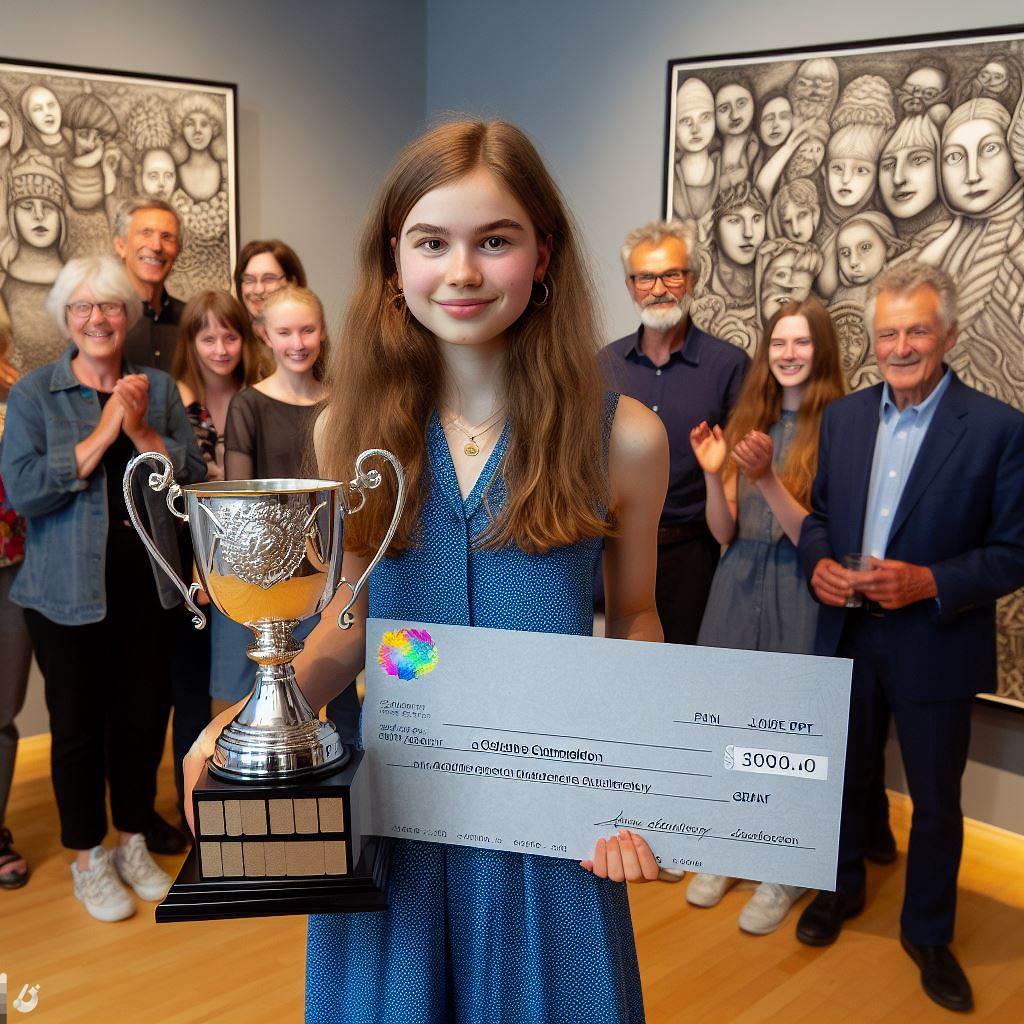Introduction
Welcome to this blog post on Canadian art grants and how to write a winning proposal.
As an artist, securing a grant can be a game-changer for your career.
It can provide you with the financial support you need to pursue your artistic vision and take your work to the next level.
Canadian art grants are available to artists across the country, and they offer a range of benefits, including funding for research, creation, and presentation of artistic works.
In this blog post, we will explore the importance of writing a winning grant proposal and how it can help you secure funding for your artistic projects.
We will also discuss the relevance and benefits of securing art grants for Canadian artists.
By the end of this post, you will have a better understanding of how to write a winning grant proposal and how to take advantage of the available resources to maximize your chances of success.
So, let’s get started!
Understanding Canadian Art Grants
Diversity of Canadian Art Grants
- Canadian art grants cater to a wide range of artistic disciplines and art forms.
- Grants are available for visual arts, performing arts, literature, music, film, and multimedia.
- Artists can explore grants for painting, sculpture, dance, theater, poetry, and digital art, among others.
- Different grants focus on supporting emerging artists, established professionals, or specific communities.
- Grants also exist for collaborative projects, research initiatives, and community development through art.
Overview of Art Grants Funding
- Government-funded grants, such as those offered by the Canada Council for the Arts, play a significant role.
- These grants are often substantial and cover various art forms and projects.
- Arts council grants, provided at federal, provincial, and municipal levels, support specific regions and initiatives.
- Private foundation grants, financed by businesses and individuals, contribute to the arts sector.
- Other funding options include corporate sponsorships, crowdfunding, and artist-in-residence programs.
Specific Aims and Criteria of Grant Programs
- Each grant program in Canada has its own specific aims, objectives, and criteria.
- Grant programs may prioritize innovation, cultural diversity, social impact, or artistic excellence.
- Some grants focus on supporting youth artists or underrepresented communities.
- Other grants aim to facilitate international collaborations and artistic exchanges.
- Criteria for selection often involve artistic quality, feasibility, community engagement, and impact.
- Artists must carefully review the guidelines and requirements of each grant program they wish to apply for.
Diversity of Canadian Art Grants
Understanding the diverse landscape of Canadian art grants is essential for artists seeking financial support for their creative endeavors.
These grants cover a broad range of artistic disciplines, including visual arts, performing arts, literature, music, film, and multimedia.
Within each discipline, there are various art forms and opportunities for artists to explore.
Overview of Art Grants Funding
Canadian art grants are offered through different avenues, such as government-funded grants, arts council grants, private foundation grants, and other funding options.
Government-funded grants, like those provided by the Canada Council for the Arts, are significant in supporting the arts sector.
They offer substantial funding and cover a wide array of art forms and projects.
Arts council grants also play an integral role in the Canadian art grants landscape.
These grants, offered at federal, provincial, and municipal levels, aim to support specific regions and initiatives.
They contribute to artistic development in local communities and often have specific criteria and objectives.
Private foundation grants are another funding option available to Canadian artists.
Financed by businesses and individuals with a passion for the arts, these grants make a substantial impact in fostering creativity and supporting artistic projects.
Additionally, artists can explore other funding sources like corporate sponsorships, crowdfunding platforms, and artist-in-residence programs.
Specific Aims and Criteria of Grant Programs
When applying for art grants, artists should be familiar with the aims and criteria of each grant program.
Each program has its own specific objectives, which may prioritize innovation, cultural diversity, social impact, or artistic excellence.
Some grants specifically support young or marginalized artists, while others focus on international collaborations and artistic exchanges.
Criteria for selection often include considerations of artistic quality, feasibility, community engagement, and potential impact.
To increase the chances of success, artists must carefully review the guidelines and requirements of each grant program before crafting their proposals.
Unlock Your Career Potential
Visualize a clear path to success with our tailored Career Consulting service. Personalized insights in just 1-3 days.
Get StartedAttention to detail and alignment with the specific objectives of each grant program can significantly enhance the proposal’s chances of securing funding.
Taking the time to understand Canadian art grants and matching them with one’s artistic goals and projects is a crucial step towards writing a winning proposal.
Read: Emerging Art Trends in Canada for 2024-2024
Researching and Identifying Suitable Grant Opportunities
Significance of conducting thorough research to find the right grant programs
Conducting thorough research is crucial to finding the right grant programs for your art project.
By taking the time to dig deeper, you can identify opportunities that align with your artistic goals and increase your chances of securing funding.
1. Understand the grant landscape
- Learn about the various grant programs available in Canada.
- Study the eligibility criteria and requirements set by different organizations.
- Identify the specific focus areas and themes of each grant program.
2. Tailor your search
- Narrow down your options based on your art practice, medium, or artistic goals.
- Consider the size of the grant, application deadlines, and funding cycles.
- Focus on grants that support projects similar to yours.
Tips on leveraging online resources, attending workshops, and networking to discover available grants
1. Utilize online resources
- Explore websites and online databases dedicated to listing art grant opportunities.
- Subscribe to newsletters and follow social media accounts of grant organizations.
- Regularly check updates and new calls for applications.
2. Attend workshops and information sessions
- Participate in workshops or webinars organized by art funding bodies.
- Learn about the application process and gain insights from experienced artists.
- Network with fellow artists and potential collaborators.
3. Network with art professionals
- Engage with art organizations, galleries, and artist communities.
- Attend art events, exhibitions, and conferences to connect with industry experts.
- Seek advice from artists who have previously received grants.
Importance of aligning the artist’s project with the goals and priorities of the grant program
When applying for a grant, it is essential to align your artistic project with the goals and priorities of the specific grant program.
1. Research the funding organization
- Visit the grant organization’s website and familiarize yourself with their mission and values.
- Understand the objectives and target audience of the grant program.
- Identify if your project fits within the scope of their funding priorities.
2. Tailor your proposal
- Highlight how your project aligns with the grant program’s goals.
- Clearly articulate the impact and relevance of your project to their mission.
- Demonstrate how your project contributes to the community or advances the arts field.
3. Be specific and focused
- Avoid generic proposals that do not resonate with the grant program.
- Clearly define your artistic vision and project objectives.
- Show how your project stands out and why it deserves funding.
Taking the time to thoroughly research grant opportunities, leverage online resources, attend workshops, and align your project with the grant program’s goals will greatly increase your chances of writing a winning proposal and securing funding for your Canadian art project.
Read: Indigenous Art in Canada: Voices and Visions
Preparing a Winning Proposal
Define the essential components of a grant proposal
- Project description: Clearly explain the project, its goals, and how it aligns with the grant program’s objectives.
- Objectives: Outline measurable outcomes that the project aims to achieve.
- Timeline: Present a realistic schedule of activities, including starting and completion dates.
- Budget: Provide a detailed breakdown of how the project funds will be allocated.
Importance of creating a compelling narrative
A grant proposal should go beyond stating facts and numbers; it should tell a story that captures the reader’s attention and conveys the artistic vision and potential impact of the project.
By crafting a compelling narrative, you can emotionally engage the reader and make them understand the significance and value of your proposed project.
Tips on writing clearly and concisely
- Use persuasive language: Choose words and phrases that evoke passion, excitement, and a sense of urgency.
- Avoid jargon: Make sure your proposal can be easily understood by both experts and non-experts in the field.
- Be concise: Eliminate unnecessary information and focus on the most critical aspects of your proposal.
- Provide evidence: Back up your claims with data, statistics, or examples to make your proposal more convincing.
- Use bullet points and headings: Break up your proposal into sections and subheadings to make it easier to skim and grasp the main points.
Tailor the proposal to the specific grant program
Avoid submitting a generic proposal to multiple grant programs. Instead, thoroughly research each grant program’s guidelines, objectives, and preferences, and tailor your proposal accordingly.
Make sure that your proposal clearly demonstrates how your project aligns with the grant program’s goals and priorities.
Adapting your proposal to the specific grant program shows that you have invested time and effort in understanding their requirements, increasing your chances of success.
Project’s potential impact
Clearly articulate the potential outcomes and impact of your project.
Describe how it will contribute to the artistic community or address a specific issue.
Showcase any previous successes or relevant experience that demonstrates your ability to deliver exceptional results.
By emphasizing the potential impact of your project, you can convince the grant review panel of its value and importance.
Review, revise, and seek feedback
Before submitting your proposal, thoroughly review and revise it for clarity, coherence, and grammar.
Consider asking a trusted colleague, mentor, or arts professional to read and provide feedback on your proposal.
Address any areas of weakness or ambiguity in your proposal based on the feedback received.
Follow the grant program’s submission guidelines
Ensure that you comply with all the grant program’s submission requirements, including formatting, word limits, and supporting documentation.
Submit the proposal before the specified deadline, allowing sufficient time for any unforeseen delays.
Double-check that all necessary attachments and supporting materials are included with your proposal.
By following these guidelines and tailoring your proposal to the specific grant program, you increase your chances of writing a winning grant proposal that secures funding for your artistic project.
Read: Balancing Art and Business: Tips for Canadian Artists
Addressing Common Mistakes and Challenges
Common errors made in grant proposals and how to avoid them
- Lack of clarity in the proposal can confuse the reviewers and lead to rejection.
- Failure to follow the guidelines provided by the granting organization can result in disqualification.
- Inadequate research about the grant and the organization can weaken the proposal.
- Grammatical and spelling errors undermine the professionalism and credibility of the proposal.
To avoid these mistakes:
- State your project’s objectives and plan clearly, using concise and straightforward language.
- Carefully review and understand all the guidelines, tailoring your proposal accordingly.
- Thoroughly research the grant, its mission, and values, aligning your proposal with their objectives.
- Proofread your proposal multiple times, ensuring proper grammar, spelling, and punctuation throughout.
Challenges artists might encounter during the proposal writing process and providing strategies for overcoming them
Proposal writing can be a daunting task for artists, but overcoming the following challenges is possible:
- Articulating the project idea: Clearly communicate your artistic vision and its significance.
- Balancing creativity and professionalism: Present your artistic skills while following the grant’s guidelines.
- Managing time and deadlines: Plan ahead and create a timeline to complete the proposal on time.
- Dealing with rejection: Use feedback to improve and continue applying for other opportunities.
Strategies for overcoming these challenges include:
- Practice describing your project ideas to friends or peers to refine your communication skills.
- Seek guidance from experienced artists or professionals who have successfully written grant proposals.
- Create a schedule and stick to it, breaking down the proposal into manageable tasks with deadlines.
- Embrace rejection as a learning opportunity, making necessary revisions and not giving up on future applications.
Examples of successful grant proposals to illustrate key points and inspire applicants
Here are two successful grant proposals for reference:
Proposal excerpt from visual artist
“My project aims to explore the relationship between technology and identity through mixed media installations. By utilizing interactive digital art and traditional sculpture techniques, my work will provoke discussions on the impact of technology on our sense of self.”
Proposal excerpt from musician
“With this grant, I will create an album that fuses jazz and hip-hop styles, combining live instrumentation with electronic elements. The music will explore themes of cultural fusion and social commentary, aiming to engage diverse audiences and bridge musical genres.”
These examples demonstrate the clarity of the project idea, adherence to guidelines, and the artist’s unique vision.
By avoiding common mistakes, overcoming challenges, and drawing inspiration from successful proposals, artists can enhance their chances of securing Canadian art grants.
Read: Art Therapy: A Growing Trend in Canadian Wellness

Review and Revision
Importance of proofreading and editing the proposal
- Proofreading and editing are crucial to ensure a polished, professional proposal.
- Grammar errors can distract reviewers and undermine the credibility of the proposal.
- Check for sentence structure to ensure clarity and coherence in conveying ideas.
- Consistency in formatting, font style, and citation method enhances the proposal’s professionalism.
Seeking feedback from mentors, peers, or professionals
- Getting input from mentors or professionals can provide valuable insights and suggestions.
- Peers can offer fresh perspectives and identify areas that need improvement.
- Feedback helps to identify strengths and weaknesses, enhancing the overall quality of the proposal.
- Revising based on feedback demonstrates a commitment to continuous improvement.
Checklist of essential elements to review before submitting the grant proposal
- Ensure the proposal addresses all the requirements, guidelines, and formatting specified by the grant.
- Review the proposal’s abstract or executive summary, ensuring it effectively summarizes the project.
- Check if the proposal clearly states the objectives, goals, and expected outcomes of the project.
- Evaluate if the proposal demonstrates a strong connection between the project and the grant’s mission.
- Assess if the proposal includes a realistic timeline and budget that align with the project’s scope.
- Ensure the proposal showcases the applicant’s qualifications, experience, and expertise.
- Check if the proposal clearly explains how the project will benefit the arts community or society.
- Review the proposal’s language, ensuring it is concise, persuasive, and free from jargon or technical terms.
- Evaluate if the proposal provides a well-organized and logical argument with supporting evidence.
- Make sure all attachments, supporting materials, and required documentation are included.
- Proofread the proposal thoroughly for spelling, punctuation, and other typographical errors.
- Check if the proposal complies with the grant’s submission guidelines, such as word count or file format.
- Review the proposal’s overall presentation, ensuring it is visually appealing and easy to read.
- Consider seeking a final review by someone who hasn’t been involved in the proposal’s development.
Submitting the Proposal
Adhering to Submission Guidelines
- Read and carefully follow the submission guidelines provided by the art grant program.
- Ensure that you understand all the requirements, including word limits, file formats, and any specific instructions.
- Double-check the submission deadlines and make sure to submit your proposal before the stated date.
- Pay attention to any formatting requirements such as font size, margins, or page numbering.
- By adhering to the guidelines, you demonstrate your professionalism and commitment to the application process.
Compiling Necessary Supporting Documents
- Review the list of required supporting documents and gather them in advance to avoid any last-minute rush.
- This may include your CV, artist statement, project proposal, budget, and examples of your previous work.
- Ensure that all documents are up to date, well-organized, and easy to read.
- Label each document clearly and match them with the corresponding sections in your proposal.
- Completing the application accurately helps to present a comprehensive and professional submission.
Maintaining a Professional Approach
- Stay organized throughout the submission process by creating a checklist or timeline.
- Read and edit your proposal several times to eliminate any grammatical errors or awkward phrasing.
- Ask someone you trust to review your proposal and provide feedback.
- Avoid excessive jargon or technical terms that may confuse the reviewers.
- Be clear, concise, and straightforward in your writing, ensuring that your ideas are easily comprehensible.
- Use a professional tone and avoid any personal biases or subjective language.
- Submit your proposal before the deadline to avoid any technical glitches or unforeseen circumstances.
- Keep a copy of your submitted proposal and supporting documents for your reference.
- If applicable, request a confirmation or receipt to ensure that your proposal was received.
- Remember to maintain a positive attitude throughout the process, regardless of the outcome.
Adhering to Submission Guidelines
Throughout the entire submission process, it is crucial to adhere to the submission guidelines provided by the art grant program.
By carefully reading and following these guidelines, you demonstrate a sense of professionalism and attention to detail.
Compiling Necessary Supporting Documents
Additionally, compiling all the necessary supporting documents well in advance will save you from a last-minute rush.
Make sure your documents are up to date, well-organized, and clearly labeled.
This organization will help reviewers navigate your proposal easily, positively affecting their perception of your application.
Maintaining a Professional Approach
Maintaining a professional approach involves more than just submitting a well-prepared document.
Staying organized, seeking feedback, and eliminating grammatical errors are essential steps.
Express your ideas in a clear, concise, and straightforward manner, using a professional tone.
Avoid jargon or technical terms that may confuse the reviewers.
Submitting the proposal before the deadline
Submitting the proposal before the deadline is of utmost importance.
Unexpected technical glitches or other circumstances can arise, so it is better to be safe than sorry.
Always keep a copy of your submitted materials for your records and request a confirmation or receipt if applicable.
Lastly, remember that the outcome is not always within your control.
Stay positive and professional, regardless of whether your proposal is successful.
Every submission is an opportunity for growth and learning.
By approaching the submission process with a professional attitude, you increase your chances of success and leave a lasting impression on the grant program’s reviewers.
Follow-up and Persistence
Stress the importance of following up with grant providers after submission
Submitting a grant proposal is just the first step in the process.
Following up with grant providers is crucial to increase your chances of success.
After submitting your proposal, take the time to reach out and express your continued interest in the grant.
This can demonstrate your dedication and professionalism.
Following up also allows you to clarify any additional information that may be needed or address any concerns raised by the grant providers.
It shows your commitment to the project and can help establish a rapport.
Suggestions for maintaining communication, expressing gratitude, and seeking feedback
Maintaining an open line of communication with grant providers is key to building a strong relationship.
It’s important to express gratitude for their time and consideration.
Send a personalized thank you note or email to the individuals involved in the grant review process.
This small gesture can go a long way in building rapport and showing your appreciation.
When seeking feedback, ask specific questions about your proposal.
This demonstrates your willingness to learn and improve for future applications.
Be open to constructive criticism and use it to strengthen your writing skills.
Consider joining professional networks or attending events where you can interact with grant providers in person.
This allows for a more personal connection and increases your visibility within the grant community.
Persistence in applying for grants, even if initial proposals are not successful
Rejection is a common part of the grant application process.
It’s important not to get discouraged by initial failures.
Review your proposal and try to identify areas for improvement.
Consider seeking feedback from grant providers to gain insights that can help you refine future applications.
Continually refine your proposal based on feedback received and keep applying to grants that align with your artistic vision.
Persistence pays off, and each application is an opportunity to learn and improve your skills.
Remember that each grant has different requirements and criteria, so don’t hesitate to tailor your proposals to specific opportunities.
Seek out workshops or courses that specialize in grant writing to gain new skills and stay informed about the latest trends and best practices in the field.
Lastly, celebrate your successes, no matter how small. Recognition and funding for your artistic endeavors are worth pursuing, and persistence increases your chances of achieving them.
By following up with grant providers, maintaining communication, expressing gratitude, seeking feedback, and persistently applying for grants, you increase your chances of writing a winning proposal.
Stay dedicated, learn from each application, and continue to refine your craft.
The art world needs your voice, and grants can help make it heard.
Conclusion
This blog post has provided some useful tips for writing a winning grant proposal for Canadian artists.
The key points discussed in this post include the importance of researching the available grants, understanding the application process, and crafting a compelling proposal that showcases your artistic vision.
A well-written grant proposal can help you secure funding, gain exposure, and advance your career as an artist.
As a Canadian artist, it is crucial to take advantage of the available resources and opportunities to maximize your chances of success.
So, start working on your own winning proposal today!
Remember to stay focused, be creative, and communicate your ideas clearly and effectively.
By following these tips and taking action, you can achieve your artistic goals and contribute to the growth and development of Canada’s art scene. Good luck!




